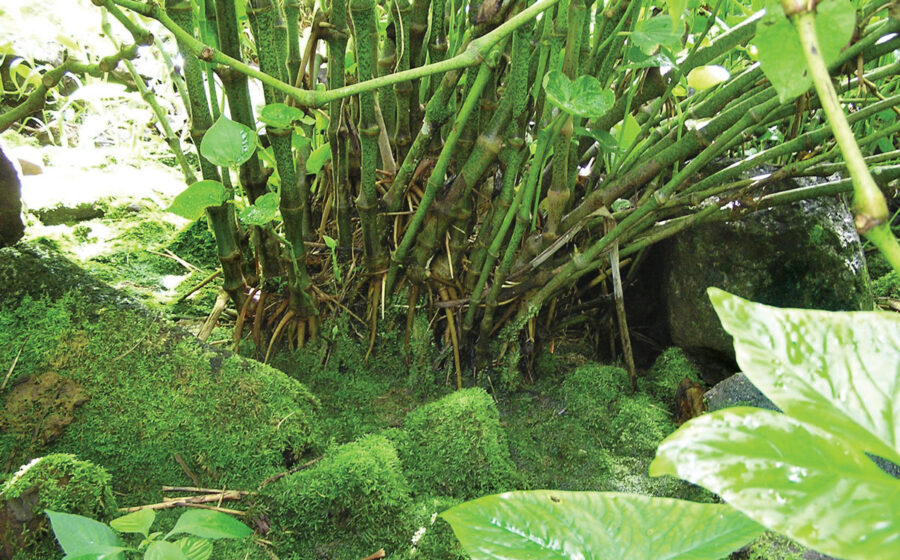[O]ver the last several years, there has been a notable increase of interest in a fascinating root known as kava kava. Once an arcane botanical item known only to a few lucky travelers, kava cafés featuring the root as a brewed tea and supplements touting its relaxing qualities are bringing this herb into the mainstream, and it’s worth a moment to consider this amazing plant a little deeper.
Kava kava root (usually simply called kava) comes from an area of the world know as Oceania, specifically the three cultural regions of Polynesia, Melanesia, and Micronesia. While the exact origin of Kava is unknown, its history of use by humans goes back over 3,000 years. Some botanists say it originated in northern Vanuatu, while others believe Papua New Guinea to be its true home. Wherever it originated, it is now cultivated and revered throughout the Pacific Ocean cultures of Polynesia as a sedative herb with spiritual potency.
At top, kava growing along a stream in Pohnpei, Micronesia. (Photo: Scot Nelson.)
Kava culture is spread across a large area of island cultures, each with their own ways of using the root. It’s used as a beverage in traditional cultures for social, ceremonial, and religious reasons. In general, social gatherings that center around traditionally prepared kava, often made from fresh roots, have an air of relaxation and joviality. This is due to the soothing effects that many people experience when drinking kava preparations—ingesting the herb is said to induce a calm (but not cloudy) euphoria, believed to be caused by kalvalactones, a compound in the plant. One of the best descriptions we have heard is that drinking kava produces relaxation without affecting mental clarity.
When we started the wholesale tea company B. Fuller’s Mortar & Pestle six years ago, we did so with a mission to bring people into a deeper relationship with the plant kingdom. Having watched the explosion of the specialty coffee market, with the intense focus on sourcing, product knowledge, and better preparation methods, we felt that teas and herbal infusions were primed for a similar movement. If a single plant, coffee, could generate so much excitement, what would happen if we started highlighting the other thousands of plants that humans have been making into delicious, healthful, and intriguing beverages for millennia?
In light of our mission, we looked to the kava root to guide us into the world of lesser-known botanicals. We put our blending expertise to use to create a signature blend pairing kava with well-loved, complementary flavors. The result is our Kava Koko tea, which remains one of our most popular herbal offerings.
Kava is exported as a dried root and its flavor profile—while not bad per se—is very earthy and base. Kava has a slight jute-like quality and a vegetal sweetness that can be lost on some palates. We wanted to make a blend that highlighted the relaxing properties of the root, but we also wanted the drink to be enjoyable. To bring sweetness out of the kava we added cacao nibs. Their immersion in hot water yields a chocolate-flavored oil that pleasantly coats the palate. And to enliven those base notes, of both the cacao and kava, we added peppermint, which brings a brightness to the blend.
We source our kava from Vanuatu, an island nation located in the South Pacific a thousand miles east of Northern Australia. We chose this remote locale because Vanuatu’s kava varieties are widely recognized as typically more potent than those from elsewhere, and Vanuatu kava is also cultivated without chemicals, which we believe is especially important for our herbal ingredients. Purity and potency aside, we were also drawn to the nation’s agricultural practices. Vanuatu’s kava cultivation is controlled by a growers association of natives, through small-scale production that provides a living for about two-thirds of the population. For those growers, kava gives a higher economic return per hectare than most other crops. The herb also offers an ecologically responsible and economically sustainable alternative to excessive tourism, heavy industry, and mining, and it helps preserve this relatively undeveloped island paradise.
We see great value in our ability to fuel the re-introduction of lesser known herbals to the wider world of tea. The natural world provides a cornucopia of amazing, beneficial compounds such as kava that can be used to improve wellness and wellbeing. We strongly believe in the idea that all living things are an integral part of an interconnected system. Herbals help us to understand and maintain that connection. Supporting kava agriculture has a cascading benefit, not only for the end consumer, but also for the culture, society, and ecology on Vanuatu.
Moreover, there is something exciting about introducing people to new experiences—especially ones that are as intimate and celebratory as a new tea or tisane. We all have special stories about the first time we tasted certain brews. By introducing people to a broader range of botanicals, we feel we are doing a service not only to our customers and our industry, but to all the lives touched by these plants.
—Joshua Russert and William Sullivan are the co-owners of B. Fuller’s Mortar & Pestle in Seattle.









